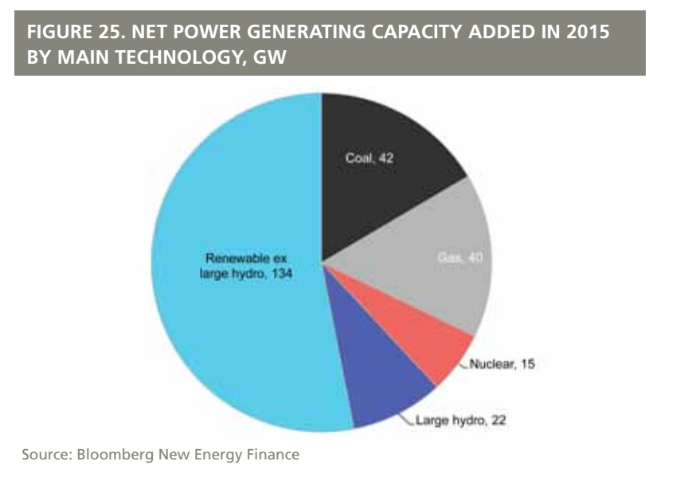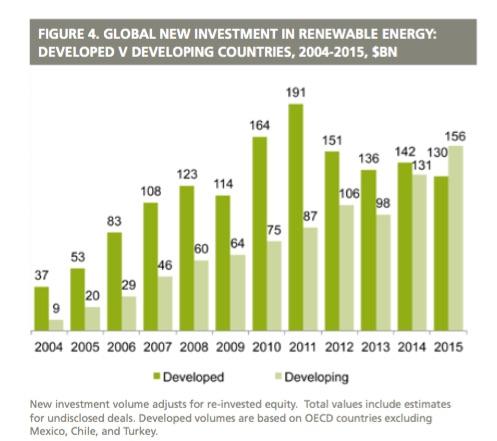Well, that’s the propaganda, anyway.
The media release is below.
Below is the key chart. It shows that although investment in new solar/wind was 200% that of new coal/gas in 2015, the added electricity generation was only 60% more. So for more than twice the investment, you get about half the electricity.

The full report is here.
###
Renewable energy investments: Major milestones reached, new world record set
For first time, developing world investments in renewables (up 19 percent in 2015) topped developed nations’ (down 8%); World record total of $286 billion invested in renewables last year, makes $2.3 trillion over 12 years
UNITED NATIONS ENVIRONMENT PROGRAMME

CREDIT: UNEP / BNEF
Frankfurt / Nairobi — Coal and gas-fired electricity generation last year drew less than half the record investment made in solar, wind and other renewables capacity — one of several important firsts for green energy announced today in a UN-backed report.
Global Trends in Renewable Energy Investment 2016, the 10th edition of UNEP’s annual report, launched today by the Frankfurt School-UNEP Collaborating Centre for Climate & Sustainable Energy Finance and Bloomberg New Energy Finance (BNEF), says the annual global investment in new renewables capacity, at $266 billion, was more than double the estimated $130 billion invested in coal and gas power stations in 2015.
All investments in renewables, including early-stage technology and R&D as well as spending on new capacity, totalled $286 billion in 2015, some 3% higher than the previous record in 2011. Since 2004, the world has invested $2.3 trillion in renewable energy (unadjusted for inflation).
(All figures for renewables in this release include wind, solar, biomass and waste-to-energy, biofuels, geothermal, marine and small hydro, but exclude large hydro-electric projects of more than 50 megawatts).
Just as significantly, developing world investments in renewables topped those of developed nations for the first time in 2015.
Helped by further falls in generating costs per megawatt-hour, particularly in solar photovoltaics, renewables excluding large hydro made up 54% of added gigawatt capacity of all technologies last year. It marks the first time new installed renewables have topped the capacity added from all conventional technologies.
The 134 gigawatts (GW) of renewable power added worldwide in 2015 compares to 106GW in 2014 and 87GW in 2013.
Were it not for renewables excluding large hydro, annual global CO2 emissions would have been an estimated 1.5 gigatonnes higher in 2015.
UNEP Executive Director Achim Steiner said, “Renewables are becoming ever more central to our low-carbon lifestyles, and the record-setting investments in 2015 are further proof of this trend. Importantly, for the first time in 2015, renewables in investments were higher in developing countries than developed.”
“Access to clean, modern energy is of enormous value for all societies, but especially so in regions where reliable energy can offer profound improvements in quality of life, economic development and environmental sustainability. Continued and increased investment in renewables is not only good for people and planet, but will be a key element in achieving international targets on climate change and sustainable development. ”
“By adopting the Sustainable Development Goals last year, the world pledged to end poverty, promote sustainable development, and to ensure healthier lives and access to affordable, sustainable, clean energy for all. Continued and increased investment in renewables will be a significant part of delivering on that promise.”
Said Michael Liebreich, Chairman of the Advisory Board at BNEF: “Global investment in renewables capacity hit a new record in 2015, far outpacing that in fossil fuel generating capacity despite falling oil, gas and coal prices. It has broadened out to a wider and wider array of developing countries, helped by sharply reduced costs and by the benefits of local power production over reliance on imported commodities.”
As in previous years, the report shows the 2015 renewable energy market was dominated by solar photovoltaics and wind, which together added 118GW in generating capacity, far above the previous record of 94GW set in 2014. Wind added 62GW and photovoltaics 56GW. More modest amounts were provided by biomass and waste-to-power, geothermal, solar thermal and small hydro.
In 2015, more attention was drawn to battery storage as an adjunct to solar and wind projects and to small-scale PV systems. Energy storage is of significant importance as it is one way of providing fast-responding balancing to the grid, whether to deal with demand spikes or variable renewable power generation from wind and solar.
Last year, some 250MW of utility-scale electricity storage (excluding pumped hydro and lead-acid batteries) was installed worldwide, up from 160MW in 2014.
Developing countries on the rise led by China and India
In 2015, for the first time, investments in renewable energy in developing and emerging economy nations ($156 billion, up 19% compared to 2014) surpassed those in developed countries ($130 billion, down 8% from 2014).
Much of these record-breaking developing world investments took place in China (up 17% to $102.9 billion, or 36% of the world total).
Other developing countries showing increased investment included India (up 22% to $10.2 billion), South Africa (up 329% to $4.5 billion), Mexico (up 105% to $4 billion) and Chile (up 151% to $3.4 billion).
Morocco, Turkey and Uruguay all joined the list of countries investing more than $1 billion.
Overall developing country investments last year were 17-times higher than in 2004.
Among developed countries, investment in Europe was down 21%, from $62 billion in 2014 to $48.8 billion in 2015, the continent’s lowest figure for nine years despite record investments in offshore wind projects.
The United States was up 19% to $44.1 billion, and in Japan investment was much the same as the previous year at $36.2 billion.
The shift in investment towards developing countries and away from developed economies may be attributed to several factors: China’s dash for wind and solar, fast-rising electricity demand in emerging countries, the reduced cost of choosing renewables to meet that demand, sluggish economic growth in the developed world and cutbacks in subsidy support in Europe.
Still a long way to go
That the power generation capacity added by renewables exceeded new capacity added from conventional sources in 2015 shows that structural change is under way.
Renewables, excluding large hydro, still represent a small minority of the world’s total installed power capacity (about one-sixth, or 16.2%) but that figure continues to climb (up from 15.2% in 2014). Meanwhile actual electricity generated by those renewables was 10.3% of global generation in 2015 (up from 9.1% in 2014).
“Despite the ambitious signals from COP 21 in Paris and the growing capacity of new installed renewable energy, there is still a long way to go,” said Prof. Dr. Udo Steffens, President of the Frankfurt School of Finance & Management.
“Coal-fired power stations and other conventional power plants have long lifetimes. Without further policy interventions, climate altering emissions of carbon dioxide will increase for at least another decade.”
The recent big fall in coal, oil and gas prices makes conventional electricity generation more attractive, Dr. Steffens added. “However, the commitments made by all nations at the Paris climate summit in December, echoing statements from last-year’s G7 summit, require a very low- or no-carbon electricity system.”
###
Renewables, excluding large hydro, still represent a small minority of the world’s total installed power capacity (about one-sixth, or 16.2%) but that figure continues to climb (up from 15.2% in 2014). Meanwhile actual electricity generated by those renewables was 10.3% of global generation in 2015 (up from 9.1% in 2014).The 115 million residences in America today collectively use an estimated 22.5% of the country’s energy. Unfortunately, a lot of energy is wasted through leaky windows or ducts, old appliances, or inefficient heating and cooling systems. When we waste energy in our homes, we are throwing away money that could be used for other things. The typical U.S. family spends at least $2,200 a year on home utility bills. You can lower this amount by up to 25% through following the Long Term Savings Tips in this guide.See more at gaslicht.com
Uhhh- that’s capacity, not “generation”.
What’s to compare?
The coal, oil, & gas infrastructure is already up. The major investments have already been made with lesser amounts needed for additional development.
Well of course the dollars developing countries invest is up. Its called coercion. The world bank wont let them invest in real usable power any more, they are forced to waste more money for less power in renewables.
Makes perfect sense that 134 GW of renewable energy was installed. Wind has a capacity factor of 0.25 and solar somewhere between 0.1 and 0.2. If we are generous and apply the wind capacity factor to all the renewables, then the amount of power generation is only on the order of 33 GW. Coal and gas are both capable of capacity factors in excess of .8 so the three top systems should be equivalent in their actual power generated. Unfortunately, the poor rate payers have to pay for 4x renewable capacity plus 1x conventional back up so politicians can show their resolve to address an existential problem in their imaginations.